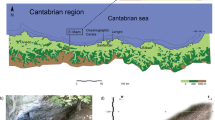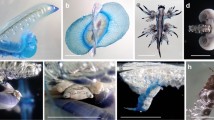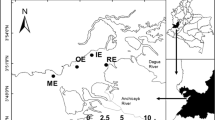Abstract
The Sundarbans Estuarine System (SES) is a mangrove dominated monsoonal, macrotidal estuarine system in the east coast of India and is one of the best nursery grounds for shellfish populations in this region. The early developmental stages of penaeid prawns prefer the estuaries to complete their bipartite lifecycle. The present study, conducted within the extremely difficult and challenging environment of the SES, is a pioneering attempt to decipher the probable diel and selective tidal variation patterns of different stages (mysis, decapodite and juvenile) of Metapenaeus dobsoni in the SES, India. The observations were conducted by selecting a time series sampling protocol of 72 hours each, during the spring and neap phases of the tidal cycle in the peak monsoon month of August 2014. During the spring and neap tides, the total population was observed to be dominated by juveniles (83%) and mysis larva (61%) respectively. The maximum abundance was observed to occur during the night time of the neap phase irrespective of tidal amplitude. During the spring phase the maximum abundance was recorded at low tide conditions irrespective of the diel variations. The increase in the abundance of mysis stages always synchronized with low tides during the neap phase whereas, the peak increase of juvenile abundance synchronized with the ebb currents (low tides) during the spring phase. M. dobsoni utilize the tidal currents for their ingress and egress mechanisms in order to travel horizontal distances or remain in their preferred habitats. Our study corroborated the significant importance of ontogenetic diel and a tidal variation of larval and juvenile’s abundance in the water column at SES. Such studies of the larval dynamics are very essential in the SES for estimating the fishery potential and sustainable management of wild seed collections by the local fishermen community.





Similar content being viewed by others
References
Attri SD, Tyagi A (2010) Climate Profile of India; Met. Monograph No. Environment Meteorology – 01/2010. India Meteorological Department, Ministry of Earth Sciences, Government of India 129
Bollens SM, Frost B (1991) Diel vertical migration in zooplankton: rapid individual response to predators. J Plankton Res 1:1359–1365
Chatterjee M, Shankar D, Sen GK, Sanyal P, Sundar D, Michael GS, Chatterjee A, Amol P, Mukherjee D, Suprit K, Mukherjee A, Vijith V, Chatterjee S, Basu A, Das M, Chakraborti S, Kalla A, Misra SK, Mukhopadhyay S, Mandal G, Sarkar K (2013) Tidal variations in the Sundarbans Estuarine System, India. J Earth Syst Sci 4:899–933
Chowdhury C, Majumder N, Ray R, Jana TK (2012) Inter-annual abundance variation in some genera of diatom and zooplankton in a mangrove ecosystem. Biodivers Conserv 21:2029–2043
Clarke KR, Gorley RN (2006) PRIMERv6: user manual/tutorial. Plymouth, UK: PRIMER-E
CMFRI (2017) Annual Report 2016-17. Central Marine Fisheries Research Institute, Kochi 292
Dall W, Hill BJ, Rothlisberg PC, Staples DJ (1990) The biology of Penaeidae. Adv Mar Biol 27
Garcia S, Le Reste L (1981) Life cycles, dynamics, exploitation and management of coastal penaeid shrimp stocks. FAO Fish Techn Pap 203
George MJ (1962) On the breeding of penaeids and the recruitment of their post-larvae into the backwaters of Cochin. Indian J Fish 9(1):110–116
Ghosh A, Schmidt S, Fickert T, Nusser M (2015) The Indian Sundarban Mangrove Forests: History, Utilization, Conservation Strategies and Local Perception; Diversity 7:149–169. https://doi.org/10.1424/2818/7/2/149
Gibson RN (2003) Go with the flow: tidal migration in marine animals. Hydrobiologia 503:153–161
Gopal B, Chauhan M (2006) Biodiversity and its conservation in the Sundarban Mangrove Ecosystem. Aquat Sci 68(3):338–354. https://doi.org/10.1007/s00027-006-0868-8
Goswami SC, George MJ (1978) Seasonal Abundance of Penaeid Prawn Larvae & Postlarvae in the Coastal Waters of Goa up to 50 m Depth Zone. Indian J Mar Sci 7:110–115
Goutam KS, Tanaya D, Anwesha S, Sharanya C, Meenakshi C (2015) Tide and Mixing Characteristics in Sundarbans Estuarine River System. Hydrol Curr Res 6:204
Grasshoff K, Kremling K, Ehrhardt M (1999) (Eds.) Methods of seawater analysis vol,1 3rd edition. Verlag Chemie Weinheim, Germany
Harris R, Wiebe P, Lenz J, Skjoldal HR, Huntley ME (2000) (Eds.), ICES zooplankton methodology manual. Academic, London
Hill AE (1991) Vertical migration in tidal currents. Mar Ecol Prog Ser 75:39–54
Hoq ME, Islam MN, Kamal M, Wahab MA (2001) Abundance and seasonal distribution of Penaeus monodon postlarvae in the Sundarbans mangrove, Bangladesh. Hydrobiologia 457:97–104
Laprise R, Dodson JJ (1989) Ontogeny and importance of tidal vertical migrations in the retention of larval smelt Osmerus mordax in a well mixed estuary. Ma Ecol Prog Ser 55:101–111
Lopez-Duarte PC, Tankersley RA (2007) Circatidal swimming behaviors of fiddler crab Uca pugilator larvae from different tidal regimes. Mar Ecol Prog Ser 343:207–220
Menon MK (1952) The life-history and bionomics of the Indian penaeid prawn Metapenaeus dobsoni (Miers). Proceedings of the Indo-Pacific Fisheries Council 3rd Meeting Sec 11:80–93
Menon MK (1955) Notes on bionomics and fishery of the prawn Metapenaues dobsoni (Miers) on the south-west coast of India. Indian J Fish 2(1):41–56
Mini KG, Sindhu KA, Sathianandan TV (2017) Marine fish landings in West Bengal during 2016–An overview. Mar Fish Infor Serv T & E Ser 233:15–17
Morgan SG, Zimmer-Faust RK, Heck KL Jr, Coen LD (1996) Population regulation of blue crabs Callinectes sapidus in the northern Gulf of Mexico: post larval supply. Mar Ecol Prog Ser 133:73–88
Morgan SG (1995) The timing of larval release. In: McEdward L (ed) Ecology of Marine Invertebrate Larvae. CRC Press, Boca Raton, Florida, pp 157–191
Mukherjee S, Mathur VB (2012) Recognizing and Rewarding Best Practice in Management of World Heritage properties. Submitted by state party: India at UNESCO World Heritage Centre. https://whc.unesco.org/uploads/sites/bestpractice2012/452.pdf. Accessed 10 Oct 2019
Mukhopadhyay SK, Biswas H, De TK, Jana TK (2006) Fluxes of nutrients from the tropical River Hooghly at the land-ocean boundary of Sundarbans NE Coast of Bay of Bengal. J Mar Syst 62:9–21
Muthu MS, Pillai NN, George KV (1978) Larval development- Metapenaeus dobsoni (Miers) in: Larval Development of Indian penaeid prawns. CMFRI Bull 28:30–40
Nandy T, Mandal S, Deb S et al (2018a) Short-term variations in surface water properties in the Sundarban Estuarine System, India. Sustain Water Resour Manag 4:559–566
Nandy T, Mandal S, Chatterjee M (2018b) Intra-monsoonal variation of zooplankton population in the Sundarbans Estuarine System, India. Environ Monit Assess 190:603
Nandy T, Mandal S (2020) Unravelling the spatio-temporal variation of zooplankton community from the river Matla in the Sundarbans Estuarine System, India. Oceanologia. 62:326–346
Queiroga H, Blanton J (2004) Interactions between behaviour and physical forcing in the control of horizontal transport of decapod crustacean larvae. Adv Mar Biol 47:107–214
Robertson AI, Duke NC (1987) Mangroves as nursery sites: comparisons of the abundance and species composition of fish and crustaceans in mangroves and other near shore habitats in tropical Australia. Mar Biol 96:193–205
Strickland JDH, Parsons TR (1972) (Eds.) A practical handbook of seawater analysis vol, 167 2nd edition. Fishery Research Board of Canada, Ottawa
Strydom NA, Wooldridge TH (2005) Diel and tidal variations in larval fish exchange in the mouth region of the Gamtoos Estuary, South Africa. Afr J Aquat Sci 30(2):131–140
Sukumaran KK, Alagaraja K, Suseelan C, Rajan KN, James DB, Subramanian T, Kakati VS, Nandakumar G, Kurup NS, Sarada PT, Sathianandan TV (1993) Stock assessment of the penaeid prawn Metapenaeus dobsoni (Miers) along the Indian coast. Indian J Fish 40(1 & 2):35–49
Treece GD, Yates ME (1988) Laboratory Manual for the Culture of Penaeid Shrimp Larvae. Marine Advisory Service, Sea Grant College Program, Texas A & M University
Ueda H, Kuwatani M, Suzuki KW (2010) Tidal vertical migration of two estuarine copepods: naupliar migration and position-dependent migration. J Plankton Res 32:1557–1572
UNESCO (1987) World Heritage List: Sundarbans National Park. http://whc.unesco.org/en/list/452. Accessed 10 Oct 2019
Vineetha G, Jyothibabu R, Madhu NV, Kusum KK, Sooria PM, Shivaprasad A, Reny PD, Deepak MP (2015) Tidal Influence on the Diel Vertical Migration Pattern of Zooplankton in a Tropical Monsoonal Estuary. Wetlands 35:597–610
Williamson CE, Fischer JM, Bollens SM, Overholt EP, Breckenridge JK (2011) Toward a more comprehensive theory of zooplankton diel vertical migration: Integrating ultraviolet radiation and water transparency into the biotic paradigm. Limnol Oceanogr 56:1603–1623
Wooldridge T, Erasmus T (1980) Utilization of tidal currents by estuarine zooplankton. Estuar Coast Mar Sci 11:107–114
Acknowledgement
The authors thank Vice Chancellor, Presidency University, Kolkata, for facilities and encouragement. We thank all members of SEP-2014 and the Marine Ecology Laboratory, who helped in carrying out the simultaneous time series measurements in Sundarbans Estuarine System. The authors thank INCOIS (MoES), MoES and FRPDF grant for the financial support. We also thank anonymous reviewers for their constructive comments. Data in this paper is part of a doctoral thesis of T.N. to be submitted in partial fulfilment of the requirements of the degree of Doctor of Philosophy from Presidency University, Kolkata.
Funding
The work was done as part of the Sundarbans Estuarine Program 2014, funded by INCOIS (MoES, Government of India) to MC. (Sanction No. F/INCOIS/HOOFS-05-2013 dated 21.06.2013) and MoES, Government of India (Sanction No. MoES/36/OOIS/Extra/24/2013) and FRPDF grant of Presidency University to SM.
Author information
Authors and Affiliations
Corresponding author
Ethics declarations
Ethical Approval
This article does not contain any studies with animals performed by any of the authors.
Conflict of Interest
The authors declare that they have no conflict of interest.
Additional information
Publisher's Note
Springer Nature remains neutral with regard to jurisdictional claims in published maps and institutional affiliations.
Rights and permissions
About this article
Cite this article
Nandy, T., Saha, A., Mandal, S. et al. Diel and Tidal Variations of Larvae and Juveniles of Metapenaeus dobsoni from Sundarbans Estuarine System, India. Thalassas 38, 255–266 (2022). https://doi.org/10.1007/s41208-021-00337-w
Received:
Revised:
Accepted:
Published:
Issue Date:
DOI: https://doi.org/10.1007/s41208-021-00337-w




